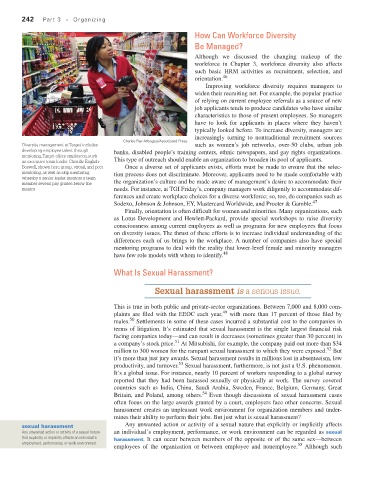Page 243 - Fundamentals of Management Myths Debunked (2017)_Flat
P. 243
242 Part 3 • Organizing
How can Workforce Diversity
Be Managed?
Although we discussed the changing makeup of the
workforce in Chapter 3, workforce diversity also affects
such basic HRM activities as recruitment, selection, and
orientation. 46
Improving workforce diversity requires managers to
widen their recruiting net. For example, the popular practice
of relying on current employee referrals as a source of new
job applicants tends to produce candidates who have similar
characteristics to those of present employees. So managers
have to look for applicants in places where they haven’t
typically looked before. To increase diversity, managers are
increasingly turning to nontraditional recruitment sources
Charles Rex Arbogast/Associated Press
Diversity management at Target includes such as women’s job networks, over-50 clubs, urban job
developing employee talent through banks, disabled people’s training centers, ethnic newspapers, and gay rights organizations.
mentoring. Target offers employees, such This type of outreach should enable an organization to broaden its pool of applicants.
as executive team leader Chenille English-
Boswell, shown here, group, virtual, and peer Once a diverse set of applicants exists, efforts must be made to ensure that the selec-
mentoring, as well as skip mentoring, tion process does not discriminate. Moreover, applicants need to be made comfortable with
whereby a senior leader mentors a team the organization’s culture and be made aware of management’s desire to accommodate their
member several pay grades below the
mentor. needs. For instance, at TGI Friday’s, company managers work diligently to accommodate dif-
ferences and create workplace choices for a diverse workforce; so, too, do companies such as
Sodexo, Johnson & Johnson, EY, Mastercard Worldwide, and Procter & Gamble. 47
Finally, orientation is often difficult for women and minorities. Many organizations, such
as Lotus Development and Hewlett-Packard, provide special workshops to raise diversity
consciousness among current employees as well as programs for new employees that focus
on diversity issues. The thrust of these efforts is to increase individual understanding of the
differences each of us brings to the workplace. A number of companies also have special
mentoring programs to deal with the reality that lower-level female and minority managers
have few role models with whom to identify. 48
What Is Sexual Harassment?
Sexual harassment is a serious issue.
This is true in both public and private-sector organizations. Between 7,000 and 8,000 com-
49
plaints are filed with the EEOC each year, with more than 17 percent of those filed by
50
males. Settlements in some of these cases incurred a substantial cost to the companies in
terms of litigation. It’s estimated that sexual harassment is the single largest financial risk
facing companies today—and can result in decreases (sometimes greater than 30 percent) in
51
a company’s stock price. At Mitsubishi, for example, the company paid out more than $34
52
million to 300 women for the rampant sexual harassment to which they were exposed. But
it’s more than just jury awards. Sexual harassment results in millions lost in absenteeism, low
53
productivity, and turnover. Sexual harassment, furthermore, is not just a U.S. phenomenon.
It’s a global issue. For instance, nearly 10 percent of workers responding to a global survey
reported that they had been harassed sexually or physically at work. The survey covered
countries such as India, China, Saudi Arabia, Sweden, France, Belgium, Germany, Great
54
Britain, and Poland, among others. Even though discussions of sexual harassment cases
often focus on the large awards granted by a court, employers face other concerns. Sexual
harassment creates an unpleasant work environment for organization members and under-
mines their ability to perform their jobs. But just what is sexual harassment?
sexual harassment Any unwanted action or activity of a sexual nature that explicitly or implicitly affects
Any unwanted action or activity of a sexual nature an individual’s employment, performance, or work environment can be regarded as sexual
that explicitly or implicitly affects an individual’s harassment. It can occur between members of the opposite or of the same sex—between
employment, performance, or work environment 55
employees of the organization or between employee and nonemployee. Although such

